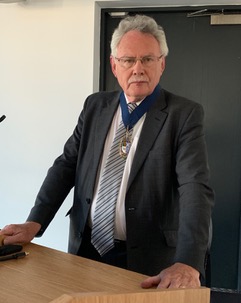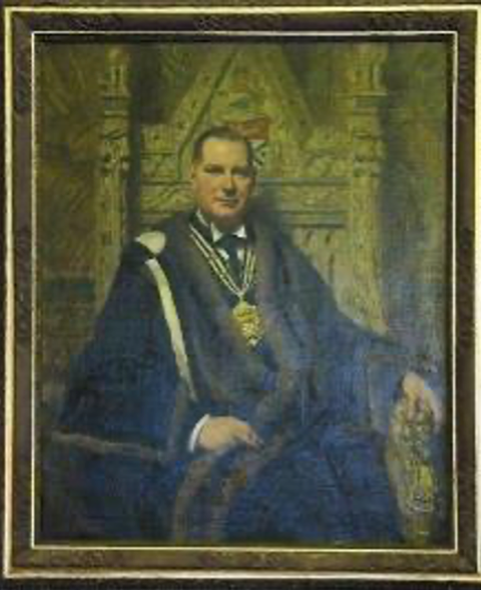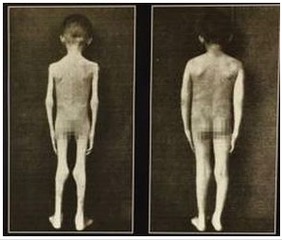3rd October 2022 – Sir Stuart Goodwin 1886-1969 – Sheffield Industrialist, Benefactor and Grateful Patient – Dr Mike Collins

Dr Mike Collins gave us a terrific talk, detailing the remarkable life of Sheffield’s Sir Stuart Goodwin. He did his medical training in Galway and was appointed Consultant Radiologist at the Royal Hallamshire Hospital, finally retiring in 2013. His great interest is medical history and he was president of the British Society for the History of Medicine in 2019.
Sir Stuart Goodwin (1886 –1969) was a Sheffield steel industrialist, born in Upperthorpe, and one of the city’s most generous philanthropists, giving over £500,000 to local, Nottinghamshire and national charities, equivalent to around £8 million today. He was head of the Neepsend Steel and Tool Corporation. He was elected Mayor of Sheffield but interestingly never made Master Cutler, although his portrait as Lord Mayor now hangs at the Cutlers’ Hall.

In 1962, he founded the Sir Stuart and Lady Florence Goodwin Charity, financially supporting many initiatives including the development of the University of Sheffield Sports Centre, construction in 1961 of Goodwin Fountain at the head of Fargate

(later replaced in 1998 by the new fountain in the Peace Gardens where no memorial for him now exists), and the Spinal Injuries Sports Club at Lodge Moor Hospital. He later donated his house in Manchester Road to the NHS for conversion to a Nurses’ Home.
The underlying catalyst for his philanthropy was his remarkably long survival to the age of 82 after developing diabetes as a young man of 37. At this time there was no treatment for diabetes other than starvation diets and Goodwin had to endure to rigors of a diet restricted to around 400 calories in 24 hours over the next three years to offset the absence of insulin in the pancreas. The production of bovine and porcine insulin sourced from local abattoirs coincided with both his own disease and Sheffield’s integral part at that time in its research development and clinical application. Banting, Best, McCloud and Collin in Canada had originally discovered the relationship between blood sugar and its control by insulin, Banting and Best receiving a Nobel Prize and sharing their prize money with the other two.
In 1920 (Sir) Edward Mellenby, Professor of Pharmacology and Physician to the Royal Infirmary teamed up with Prof J Leathes (physiologist), surely one of the earlies examples of multidisciplinary working, to initiate clinical trials of insulin in 1923 at the Royal Infirmary in Sheffield. Mellenby had already discovered that cod liver oil prevented rickets and his high academic profile was acknowledged by the Medical Research Council in recommending Sheffield as a major clinical research centre to join London and Edinburgh for the insulin trials. According to Harold Swan, Goodwin told Mellenby he knew he was going to die very soon, but that “he had not made up his mind whether to die of starvation or die of diabetic coma”.
The Sheffield Daily Telegraph published a report on the 23rd February 1923, stating “In Sheffield its (insulin) use is being surrounded by the greatest possible secrecy but our representative learns that there are two diabetic patients undergoing this treatment at the Royal University Department of Pharmacology”. In a later report on the 23rd September 1923 referring to the Royal Infirmary, it was stated that “the first patient to receive the new treatment there was a Sheffield gentleman (actually Stuart Goodwin) who has been worn to ‘skin and bone’ by the ravages of the ailment. His was largely an experimental case, but so effectively did the insulin work that he gained an extra 6st on top of his skeletal 6st! He was at first unrecognisable when he eventually returned to work”.
Figure 4 shows the very first diabetic patient to be given experimental insulin. For copyright reasons, hospital archival images of Sir Stuart Goodwin before and after treatment cannot be published.

Soon afterwards Goodwin became a benefactor. After his retirement, he moved to Retford, serving as Lord Lieutenant of Nottinghamshire and was elected president at Lindrick Golf Club, sponsoring the Ryder Cup there. When Sir Stuart died in June 1969, more than 2,000 mourners attended his funeral in Sheffield Cathedral. Truly a great man of Sheffield.
